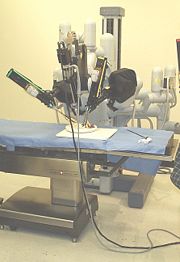 | | __ |
|
| Today is |
|
Da
Vinci Surgical System
|
The da Vinci surgical system made by Intuitive Surgical is a robotic surgical system. It is most commonly used for prostatectomies, cardiac valve repair and gynecologic surgical procedures, but can be used for any abdominal or thoracic surgical procedures. It has four robotic arms, three of them are for tools that hold objects, act as a scalpel, scissors, bovie, or unipolar or dipolar electrocautery instruments. The fourth arm is for a camera with two lenses that gives the surgeon full stereoscopic vision from the console. The surgeon sits comfortably and looks through two eye holes at a 3-D image of the procedure, meanwhile maneuvering the arms with two foot pedals and two hand controllers. AdvantagesThe "'Da Vinci surgical system'" is minimally invasive, meaning the incisions used for surgery are very small. The arms also take away the tension and stress inflicted upon the incisions in laparoscopic surgery. The patient is therefor more apt to recover quickly and leave the hospital, reducing the average cost of keeping a patient in the hospital(after having surgery with the Da Vinci) by 33%. The Da Vinci allows the surgeon to be more precise in his surgery, and operate with significantly less shake than in a normal unassisted procedure. The surgeon can operate around delicate blood vessels and operate on some of the surgically difficult tumors that could not be removed before. The visualization of the Da Vinci has many advantages, giving the surgeon control of the camera and giving the surgeon a 3-D image upon which to operate on. The Da Vinci even stimulates pressure to the surgeon's controllers when he presses against something with one of his instruments. The Da Vinci elicits positive publicity towards the hospital where it's stationed, oftentimes effecting a patient's decision over the hospital they go to for medical care in general. Disadvantages The "'Da Vinci surgical system'" costs around one million dollars. It also increases operations 50-90 min in order to set up the ports, which costs the hospital money. The machine takes up a lot of space, it is very large and inconvenient. Insurance companies oftentimes have a budget for what a particular procedure should cost, and the Da Vinci sometimes pushes the cost over that budget. When this occurs, the hospital is forced to pay the expenses, however the doctor does not get payed extra and the patient does not have to pay extra in order to compensate for the added expenses. The Da Vinci is still new in terms of medical equipment. Surgeons and patients alike are still skeptical and cautious about its usage. It is important to note that when laparoscopic surgery first came out public sentiment was very similar. Today the majority of surgeries are done laparoscopically. Procedures The "'Da Vinci surgical system"' is most commonly used for prostatectomies, cardiac valve repair, and gynecologic surgical procedures. The Da Vinci is useful in procedures that are focused on one specific area of the abdomen or thorax. Procedures that are not localized and require the surgeon to move around to different areas are very inconvenient, considering the time it takes to set up the Da Vinci's ports. Surgeons are beginning to employ the Da Vinci to remove tumors on the liver and pancreas, on account of the delicacy of the procedure, the number of blood vessels that the surgeon must deal with, and the single location of the operation. Future The Da Vinci could one day be used to preform truly remote operations. The possibility of long distance operations depend on the patient having the Da Vinci machine and someone to put in the ports, but technically the machine could allow a doctor in the U.S. to do surgery on a patient in Antarctica.
|
HISTORY OF ROBOTS -- ROBOTS IN SPACE -- ROBOTIC SURGERY -- ROBOTS IN THE MILITARY -- MORE -- Basics -- Robotics Robotics in Space Robotics in Medicine Robots in the Home Robots in the Military |
